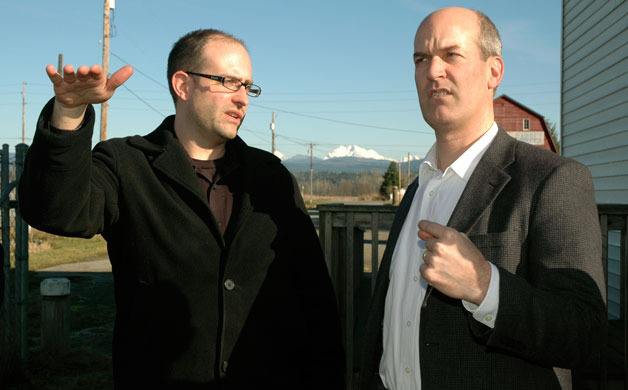MARYSVILLE — Transportation improvements dominated the agenda of U.S. Rep. Rick Larsen’s visit to the city of Marysville on Feb. 1.
Marysville Mayor Jon Nehring, City Engineer John Cowling and Planning Manager Cheryl Dungan guided Larsen and his staff through a brisk afternoon driving tour of State Avenue north to Smokey Point, and then back down to the State Route 529 bridge replacement construction, to give the Congressman a firsthand look at how the city’s projected improvements would impact traffic, commerce and quality of life in north Marysville.
Cowling explained that the city has already spent the past several years applying for grants to increase from three lanes to five lanes in the section of State Avenue between 116th and 136th streets, as well as to add continuous sidewalks along both sides.
“Right now, people are using the goat trail as their walking path, and traffic on this section of street can get backed up a quarter-mile,” Cowling said. “It’s on the citizens’ radar that these improvements need to come in.”
Nehring explained that the 156th Street overcrossing, which is currently set to go out to bid in April, would connect Smokey Point Boulevard to Twin Lakes Avenue, not only to alleviate traffic pressure on 172nd Street over Interstate 5, but also to foster the light industrial and manufacturing jobs that Nehring is hoping to attract to north Marysville. When Larsen asked if the Fidelity Grange would be torn down to make way for the overcrossing, Nehring confirmed that it would, but noted that the city had tried to find a way to move it first.
Dungan added that the Army Corps of Engineers had already determined jurisdiction on 600-plus acres in north Marysville, for which Nehring pointed out that the city had already paid $9 million in stormwater utilities.
“We’re 75 percent of the way there,” Nehring said. “We’re just looking for that remaining $3 million.”
“PUD already has a substation in place in the area,” Cowling said. “We’re really primed and ready to go.”
Larsen acknowledged that government budgets remain tight, but he touted the value of getting an on-the-ground look at what opportunities cities like Marysville will need to take advantage of in an eventual economic recovery.
“This gives me another picture of the infrastructure that’s needed to help create jobs,” Larsen said. “Even during a recession, a city like Marysville can get their plans in place, and we’ll do what we can to help connect them with federal funding.”



